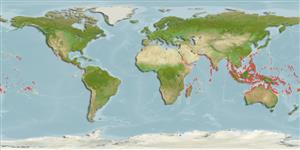Common names from other countries
Environment: milieu / climate zone / depth range / distribution range
Ökologie
seewasser; süßwasser; brackwasser demersal; amphidrom (Ref. 51243); tiefenbereich 0 - 5 m (Ref. 86942). Tropical; 25°C - ? (Ref. 2059); 45°N - 27°S
Indo-West Pacific: throughout the Indo-Pacific, from east African coasts to Philippines, Melanesia and Polynesia (Ref. 6802); east African coast south to Transkei (Ref. 52193).
Size / Gewicht / Alter
Maturity: Lm ? range ? - ? cm
Max length : 26.0 cm TL Männchen/unbestimmt; (Ref. 5493)
Rückenflossenstacheln (insgesamt) : 7; Rückenflossenweichstrahlen (insgesamt) : 8; Afterflossenstacheln: 1; Afterflossenweichstrahlen: 8. Diagnosis: Longitudinal line scales 57-68; preopercular spine present; 8-10 gillrakers on lower part of first branchial arch (Ref. 5493, 79840). Dark brown to black in color; horizontal lines on body; young with spotted fins (Ref. 5493).
Adults inhabit lagoons, estuaries and freshwater (Ref. 6028, 48637, 79840). They occur in the lower reaches of freshwater streams, usually on mud bottoms (Ref. 44894). Juveniles are found mainly among mangrove roots in the more saline areas of lagoons and estuaries (Ref. 6028, 79840). Carnivorous (Ref. 79840). Marketed fresh (Ref. 12693).
Life cycle and mating behavior
Maturities | Fortpflanzung | Spawnings | Egg(s) | Fecundities | Larven
Spawns eggs on submerged plants with small leaves. Female tends and fans the eggs until hatching and loosely guards the fry for a few days thereafter.
Maugé, L.A., 1986. Eleotridae. p. 389-398. In J. Daget, J.-P. Gosse and D.F.E. Thys van den Audenaerde (eds.) Check-list of the freshwater fishes of Africa (CLOFFA). ISNB, Brussels; MARC, Tervuren; and ORSTOM, Paris. Vol. 2. (Ref. 6802)
IUCN Rote Liste Status (Ref. 130435)
CITES (Ref. 128078)
Not Evaluated
Bedrohung für Menschen
Harmless
Nutzung durch Menschen
Fischereien: weniger kommerziell; Aquarium: Kommerziell
Tools
Zusatzinformationen
Download XML
Internet Quellen
Estimates based on models
Preferred temperature (Ref.
115969): 25.4 - 29.3, mean 28.5 (based on 3082 cells).
Phylogenetic diversity index (Ref.
82804): PD
50 = 0.5000 [Uniqueness, from 0.5 = low to 2.0 = high].
Trophic level (Ref.
69278): 3.8 ±0.3 se; based on diet studies.
Widerstandsfähigkeit (Ref.
120179): mittel, Verdopplung der Population dauert 1,4 - 4,4 Jahre. (Preliminary K or Fecundity.).
Fishing Vulnerability (Ref.
59153): Low vulnerability (16 of 100).
